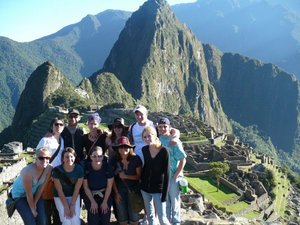Students visit Inca capital

Seven Chadron State College students had a unique experience earlier this summer. They spent three weeks in Peru, South America, learning about both the Incan empire that flourished there centuries ago and modern times in that part of the world. The trip was led by Dr. Alison Krogel, who taught Spanish at CSC in 2006-2007. She spent most of 2005 in Peru while she was a graduate student at the University of Maryland.
The students lived with host families in Cuzco, a city of about 300,000 people that lies 11,600 feet above sea level in the Andes Mountains. Cuzco was the capital of the Incan empire and also was an important colonial city after the Spanish invasion in 1534.
The CSC students primarily studied Spanish grammar and conversation four hours a day at a language institute located in the historic San Blas neighborhood. They also had lessons in Peruvian cooking and salsa dancing and took a Quechua language course.
Quechua is the indigenous language spoken by 12 million people in the Andean region of South America, Krogel said.
Lots of sight-seeing also occurred, particularly to archeological ruins surrounding Cuzco. The students initially traveled by bus, then rode a train and finally hiked after the tracks ended to visit ruins in the Sacred Valley of the Incas and the imperial city of Machu Picchu.
Krogel and several students said Machu Picchu is particularly impressive. It is located near the valley of the Urubamba River, which eventually dumps into the Amazon. While there, most of the students climbed to the top of Wayna Picchu, a peak that offers impressive views of the surrounding semi-tropical forest and the astronomical temples of the moon and sun.
Krogel said the Incas used these strategically-located temples to determine the best times to plant and harvest their crops.
About half the students also earned three more credits in Andean literature, history and culture. This course was taught by Krogel and included more visits to archeological ruins, museums, cathedrals and other important cultural sites in Cuzco.
The CSC students who participated in the trip were Kerri Adkins, Ogallala; Tess Draper, Bridgeport; Angie Hilliker and Jennifer Wright, Chadron; Jared Koester, Peetz, Colo.; Chisolm McDonald, Sturgis, S.D.; and Paul Nelson, Denver. Also making the trip were Elizabeth Bartlett, who attends Western Nebraska Community College, and Kara Flaherty, a student at the University of Nebraska-Kearney.
Koester said he was particularly impressed with the Incan architecture.
“It is amazing what they could build with the tools they had. They cut huge boulders and made them fit together perfectly. You can’t put a piece of paper between them.”
Nelson said the ruins at Machu Picchu show how advanced the Incan culture was hundreds of years ago. He noted that the Incas’ use of astronomy structures still amazes scholars and scientists. They were a key to the ancient civilization’s survival because the region is close to the equator and the changes in the seasons are not nearly as noticeable as in places like the United States that are much farther away.
Nelson also was impressed by the people who live in the Andes Mountains today. He said they grow vegetables such as potatoes, corn and beans in plots high on the mountains, utilizing seeds that are adapted to the altitude.
Much to the appreciation of CSC Science Professor Ron Weedon, the founder of the Chadron State herbarium, Nelson obtained 31 packets of various seeds from the Andes region and contributed them to the Chadron State herbarium.
Category: Campus News, Student Awards & Achievements, Student Clubs & Organizations
